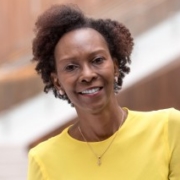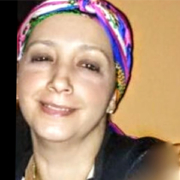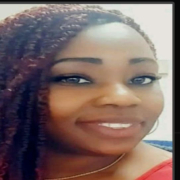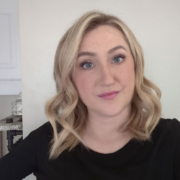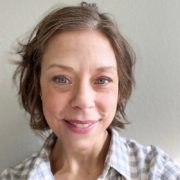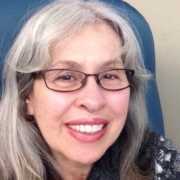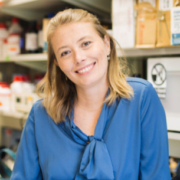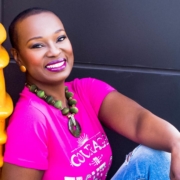Lianne Kraemer was a Pediatric Speech Language Pathologist before her stage 2 breast cancer diagnosis at age 37. Despite receiving aggressive treatment, her cancer returned as stage IV MBC at age 39. Lianne’s initial metastatic diagnosis was that of brain metastases only. Her medical team has utilized systemic therapies and radiation to manage her disease. Lianne’s experience living with active and progressing brain metastases and participating in multiple clinical trials has made her passionate about increasing patient participation and access to clinical trials.
Full Transcript
Clinical Trials Part 1
Lianne Kraemer:
I was diagnosed with early stage breast cancer in January of 2014 and I got all the appropriate treatment, and then was finished with my care. In June of 2016, I had some tingling in the right side of my face. So that symptom prompted an MRI, which showed that I had brain metastasis.
My oncologist did scans of the rest of my body because generally we don’t see brain mets going straight to the brain as a first site of metastasis. And especially in hormone-receptor-positive, but in any subtype, it’s not generally seen that way. So we expected to find disease in the body, but we did not. We did a bone scan and a CT and there was no evidence of disease anywhere else outside of the brain.
At the time, like I said, it was June 2016, it was just brain mets. And it’s funny to say “just” cause, you know, it’s weird what becomes a good thing. And I was grateful that there was no disease anywhere else. At the time, I think it was about 12 brain mets and I went to meet with the oncologist to develop a treatment plan.
And initially we were going to do whole-brain radiation. That was kind of the standard back then with that many mets. Actually I like being able to say “back then” – it’s been long enough that things have changed a little bit. And that not necessarily do we look at whole-brain radiation as the first thing for that many mets. Sometimes it’s needed.
But I was in the middle of simulation with the radiation oncologist when his phone rang and it was actually – so it was in the building – and it was actually the oncologist calling me. And so I got on the phone in that room and she said, “after you’re finished with him, come back upstairs. I want to talk to you a little bit about a clinical trial.”
So we’re talking within days of my metastatic diagnosis, days of finding out I have brain mets, so very new in understanding anything about brain mets and metastatic disease and how it’s treated. And, you know, my doctor kind of said, you know, there’s a really good chance that whole-brain radiation will just wipe the slate clean in your brain. And I think that’s kind of what we all want with metastatic disease. We just want them all gone and we want them gone now.
So when I went back upstairs and talked to the medical oncologist, she started talking about a clinical trial that they had open. And I was really confused. I held all of the misconceptions that really exist around clinical trials. I thought clinical trials were something that, you know, was a last ditch effort. I thought, you know, why would I trade a known treatment that, you know, they’re telling me is possibly going to make it all go away. For what was a specific brain mets trial – it was actually for the drug Verzenio, abemaciclib was its name before its branding. And it was obviously a systemic drug.
And so I was a little confused by all of that. And it kind of seemed counterintuitive to me to risk letting the metastasis in my brain grow by entering a clinical trial rather than just doing the whole-brain radiation. It just didn’t make sense to me.
But I spent some time, after, you know, talking to her about it and learning more about clinical trials. And, you know, what I learned is that everything that we ever do, ever, whether it was in your early stage diagnosis or a drug that’s in-treatment that you use later on, or whole-brain radiation even has been studied in a clinical trial and that what they’re studying is what they hope to be a better treatment than currently exists. So you’re looking at possibly the advancement to the newest and best drug possible.
My oncologist also explained that there’s a limited timeframe with clinical trials and while whole-brain radiation will always be there, there are only allowed certain people in a clinical trial. And that this particular trial had three arms. It was for melanoma, lung cancer and brain mets. And the lung cancer and the melanoma arm had already filled. So nobody else could get on that trial. And so while the breast cancer arm was still open, it could close up if I chose not to do it. And then, I wouldn’t be able to get on that drug and if it turned out to be a good drug, I would have to wait, possibly a long time, to have access to it.
So that was another thing that really helped me understand how clinical trials are advantageous to use. I also spoke a lot to other doctors that I’m connected with and just gained better understanding. And so I did decide to go with that clinical trial, and it turned out to be, in the course of my five years of treatment, it has been the best treatment for me. Nothing else has compared, no other drug or treatment has compared to how well I did on that, and for how long I was on it.
So I really look at that as kind of bonus time, especially at the time – it’s now FDA-approved, obviously, but, you know, it took a long time for it to get FDA-approved after I had already gone on it for trial. So, it was really a turning point in my treatment. And I understood that it’s better to do trials in the beginning because you can – once you have a number of treatments, you become, what they call, heavily pretreated, and that you’re more likely to be able to participate in a trial and not be excluded because you’re heavily pretreated in the beginning.
So it was, you know, a really great thing for me. Back after that trial was completed, I was like, what’s the next trial? I now want to do another trial. So I became a very big fan of clinical trials.
Clinical Trials Part 2
Lianne Kraemer:
So I was a huge fan of clinical trials after my first experience. And, you know, in that process of it, I really liked the clinical trial setting. You were watched and monitored very carefully, even more so, I was told, than – I didn’t have any experience outside of that because it was my first line of treatment, but there’s lots of people meeting with me and following me and calling me and making sure that I was doing okay. And you’re really closely monitored for anything that’s going on and they’re very attentive to your needs.
And so my second line of treatment was also a clinical trial. It was specifically for brain mets, as well. And I actually know that I got the very last slot on that trial. That was a pretty … after having done my first trial where the conversation with a clinical oncologist, at that time, was like, you can miss out on a trial because they can fill. And so, I knew what drug we would do if I didn’t get on the trial, because I did have to wait to find out if I was admitted. And so, you know, that drug wasn’t going anywhere. It was always gonna be there. And whether this drug worked for me or not, that I was going to use on this clinical trial, was a systemic treatment option. I knew, regardless of getting on, that the drug that was the second choice was going to be there.
I did get on the trial and got the last slot, which was pretty amazing. And that trial worked for me for close to eight months. The interesting thing about that clinical trial is that years later, I asked my oncologist how that trial worked out. You know, was it moving along and how people were doing on it. And she actually said that it didn’t do well. The drug did not show that it met its end points. And so it didn’t continue.
But it actually worked well for me. I mean, eight months is eight months, and that drug was never approved. Women don’t have access to that drug and, you know, whether or not somebody else would do well or not do well, it doesn’t matter so much if it worked well for me. You know, again, I look at that as bonus time that’s been added to my life. Because then after that trial was completed, we went on to the next drug, which was actually Xeloda.
So if I hadn’t done that drug I would have started Xeloda eight months sooner. And so it’s definitely something I look at from a standpoint, scientifically, it’s very interesting how I performed on it and that it gave me that extra time. And I just learned that clinical trials are so beneficial from a standpoint of how they help me, can help, may help you as a patient. But also what they do from a standpoint of research and understanding that the faster we enroll trials, and get people to do them, the faster that drug can come to market, because until that clinical trial is filled, which can take six months to two years or three years, that just delays that drug getting approved, if it does show that it has good efficacy in the brain, if that’s what we’re looking at.
So it’s really important to participate in trials. It’s kinda like giving back, in a way. I look at it like the drugs, like Xeloda, at one point, was somebody’s drug that they were looking at in a clinical trial and thinking, do I want to do this? And then it became a standard of care drug. And now Verzenio is a standard of care for brain mets. So it’s really interesting how it comes full circle.
2nd Opinion
Lianne Kraemer:
I started my treatment for metastatic brain mets with one oncologist. She was fantastic in that she had gotten me on a clinical trial that really made a difference in my care. You know, right after my trial started, I needed some reassurance that I was moving in the right direction with it. And so I do have a background in being in healthcare, and recognize that all doctors have different areas that they like to focus on and specialties.
So I did some research and I found out who was doing the most in the brain mets space, both in taking care of patients and research. Her name kept reoccurring under current trials and past trials. And after feeling confident, I called up and got an appointment with her, and they were wonderful in fitting me in. I just needed somebody to confirm. You know, anybody who’s been diagnosed with brain mets, or metastatic disease in general, it’s terribly frightening. You’re dealing with your life and I think we all want to make sure that we’re getting the best care we possibly can. And so I just needed that confirmation that that clinical trial was the right direction. I knew that I could stop the clinical trial at any point if I wanted to.
So about a month after I started the clinical trial, I had a second opinion and really liked the physician. Her name is Dr. Nancy Lin, and really liked her a lot. And she confirmed that if she had been my treating oncologist, that that’s what she would have picked out for me as well. And that was really reassuring to hear her agree with the oncologist that I was seeing locally at the time. It gave me just the confidence I needed to continue on with that clinical trial. I was still within like six weeks of being diagnosed with metastatic disease. So everything is still very raw and new to me. So it was just really good to get that confirmation.
The plan at that time was that she would consult with my local oncologist and that they would touch base when needed. That absolutely took place and while we did that for a while, the one thing that I didn’t like about that situation is that I wasn’t included in those discussions, and it wasn’t because they purposely excluded me. It just was the way that it worked – the two doctors would chat and have a conversation about what was going on, and then the message was relayed to me.
And I was left with questions. You know, my oncologist didn’t specialize in brain mets. That’s not something that’s a negative. You don’t have to have a doctor that specializes in brain metastasis, but knowing that Dr. Lin was out there and, you know, I had additional questions that I wanted answered and didn’t really have access to her, I went back to her a second time. And at that point I decided just to switch my care to her.
So I could have kept it that she continued to consult with my local oncologist and that they worked as a team. But for me, I just, I needed more than that. So I did switch my care to her. And although I lived in one area – I lived in Chicago, actually at the time, I lived in St. Louis, I’ve kind of moved around a little bit, but I flew to see her for my scans and treatment in Boston. And was a lot – it is a lot of work. I still do it to this day. I’ve been doing it for nearly five years.
And that’s just what has worked for me. But it doesn’t mean you have to do that. You know, people use second opinions, like I said, to confirm that what they’re doing is what that oncologist would do because they have an expertise in it. And I think it’s a good sign when your oncologist is willing to work with somebody else. You know, the medical field, in general, is complex, no matter what disease you’re dealing with, and nobody has all the answers for everything. So the more input you get, in my opinion, the better.
So having, you know, a team approach where you’re having two oncologists bounce ideas off of each other, I think is a best case scenario. Especially with brain mets, it’s a really complicated area of the disease to treat. And to have somebody who, that’s their main focus, working with your oncologist, or if you choose that person being your oncologist – generally when you work with somebody who specializes in brain mets, like I do, they work in a team setting. So I’m seen by a medical oncologist, a radiation oncologist and her oncologist was later added when I needed that. And she knew that, Dr. Lin, knew to add that because of her experience with brain mets and that being her area of expertise. So that has worked out, in my needs, the best way it possibly can.
Advice to Patients (NOTE: This video is on the Advice Section of the website).
Lianne Kraemer:
My one piece of advice to somebody who has been newly diagnosed with brain metastasis is, and I wish I had known this, is not to get too hung up on the statistics. It’s really easy to see those numbers and just let them swallow you whole. It can be so depressing. When I was diagnosed with brain mets in 2016, everything I read in research articles online said about 10 months to a year.
And so I immediately just kind of flew into this, like throwing things away and just really, it was terrible for me. And I know, I imagine most patients do that. You see this statistic and you picture yourself as that statistic. When I talked to my oncologist some more, it was more like two years, which still, you know, no matter what age you are, somebody telling you that your life expectancy is two years is devastating.
But there’s a couple of things to take into account with that. First of all, you are not a statistic. You’re not. So no matter what the statistics say, just remember that you are an individual person and that your body is going to react in a way that’s unique to yourself. Statistics are made up of averages of everybody, and there’s people that fall below that average, and people that fall above it. And you just never know how you’re gonna perform, or how the drugs are going to perform for you. I, kind of, initially was just so focused on that statistic that it swallowed me whole.
And then the longer that I went, and I kind of eased into things, I kind of functioned in two different lanes. I kind of describe it being in like two different lanes of traffic. And I focused on, okay, they’re saying two years and so I did the things that I needed to do – let’s say that was my life, that I would live two years. And I took care of those, you know, matters that you needed to take care of – I did a will and all that stuff. And it’s all very hard, but I did that stuff.
But then I lived in another lane, or another world, where I don’t want to say necessarily was hope or optimism, but just the possibility that wasn’t going to be my trajectory in life. And so I allowed myself to make plans and do things that were beyond the expectation of two years. Cause you just kind of have to work what’s best for you. But I can’t stress enough how important it is not to get stuck on those statistics that you see on paper, because you are not that.
And the other thing that you need to take into account for – and something that actually happened to me is that – the statistics, as they are at the moment you read them, are constantly changing. So when I looked at the statistics, they didn’t include a new drug that I went into clinical trial for and was later FDA-approved. And that impacted my life expectancy. And so don’t get hung up on what it says on that paper, because it’s not taking into account the new drugs that are constantly going into clinical trials, that are being FDA-approved.
And so the life expectancy you read, like, what I read online was 10 months, but what my doctor told me was two years. But here I am five years later. So I’m just telling you not to get hung up on those stats because it’s really easy to do and terrifying. And while you have to give those statistics some credibility, because they are there for a reason, don’t let yourself be defined by it.


